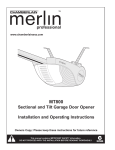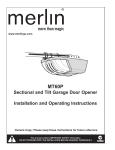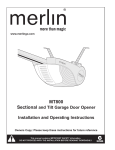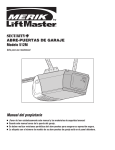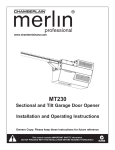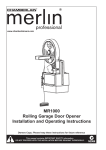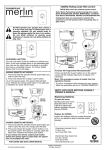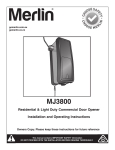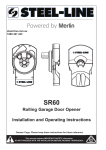Download Merlin MT5580P Operating instructions
Transcript
www.merlingo.com profes www.c siona hamb l erlain anz.c om MT5580P Sectional and Tilt Garage Door Opener Installation and Operating Instructions Owners Copy: Please keep these instructions for future reference This manual contains IMPORTANT SAFETY information. DO NOT PROCEED WITH THE INSTALLATION BEFORE READING THOROUGHLY. N2966 START BY READING THESE IMPORTANT SAFETY INSTRUCTIONS WARNING • Failure to comply with the following instructions may result in serious personal injury or property damage. • Read and follow all instructions carefully. • The garage door opener is designed and tested to offer safe service provided it is installed and operated in strict accordance with the instructions in this manual. These safety alert symbols mean WARNING : A possible risk to personal safety or property damage exists. Keep garage door balanced. Do not let the garage door opener compensate for a binding or sticking garage door. Sticking, binding or unbalanced doors must be repaired before installing this opener. Do not wear rings, watches or loose clothing while installing or servicing a garage door opener. Frequently examine the door installation, in particular cable, springs and mountings for signs of wear, damage or imbalance. Do not use if repair or adjustment is needed since springs and hardware are under extreme tension and a fault can cause serious personal injury. To avoid serious personal injury from entanglement, remove all ropes, chains and locks connected to the garage door before installing the door opener. Installation and wiring must be in compliance with your local building and electrical codes. The safety reverse system test is very important. Your garage door MUST reverse on contact with a 40mm obstacle placed on the floor. Failure to properly adjust the opener may result in serious personal injury from a closing garage door. Repeat the test once a month and make any necessary adjustments. This opener should not be installed in a damp or wet space exposed to weather. This appliance is not intended for use by persons (including children) with reduced physical, sensory or mental capabilities, or lack of experience and knowledge, unless they have been given supervision or instruction concerning use of the appliance by a person responsible for their safety. The Protector SystemTM must be used for all installations where the closing force as measured on the bottom of the door is over 400N (40kgf). Excessive force will interfere with the proper operation of the Safety Reverse System or damage the garage door. After installation, ensure that the parts of the door do not extend over public footpaths or roads. Install the wireless wall control (or any additional wall control) in a location where the garage door is visible, at a height of at least 1.5m and out of the reach of children. Do not allow children to operate push button(s) or transmitter(s). Serious personal injury from a closing garage door may result from misuse of the opener. Permanently fasten the Warning Labels in Prominent Places, adjacent to Wall Controls and manual release mechanisms as a reminder of safe operating procedures. Activate opener only when the door is in full view, free of obstructions and the opener is properly adjusted. No one should enter or leave the garage while the door is in motion. Do not allow children to play near the door, or door controls. Disconnect electric power to the garage door opener before making repairs or removing covers. KEEP THESE INSTRUCTIONS Warning: If your garage has no service entrance door, a CM1702 outside quick release must be installed. This accessory allows manual operation of the garage door from outside in case of power failure. CONTENTS PAGE SAFETY INSTRUCTIONS . . . . . . . .2 DOOR TYPES . . . . . . . . . . . . . . . . .3 TOOLS REQUIRED . . . . . . . . . . . .3 HARDWARE PROVIDED . . . . . . .3-4 BEFORE YOU BEGIN . . . . . . . . . . .5 COMPLETED INSTALLATION . . . .5 ASSEMBLY . . . . . . . . . . . . . . . . .5-7 INSTALLATION . . . . . . . . . . . . .8-14 ADJUSTMENT . . . . . . . . . . . . . . . .14 SAFETY REVERSE SYSTEM . . . .15 2 INSTALL IR SAFETY BEAMS . . . .15 WIRED DOOR CONTROLS . . . . .16 WIRELESS PROGRAMMING . . . .17 SPECIAL FEATURES . . . . . . . . . .18 ACCESSORIES . . . . . . . . . . . . . . .19 SPECIFICATIONS & SAFETY . . .19 OPERATION OF YOUR OPENER 20 MAINTAINING YOUR OPENER . .20 CARE OF YOUR OPENER . . . . . .20 REPLACEMENT PARTS . . . . .21-22 TROUBLESHOOTING . . . . . . . . . 23 WARRANTY . . . . . . . . . . . . . . . . .24 1 DOOR TYPES A. One-piece door with horizontal track only B. Sectional door with curved track A C. One-piece door without track To suit spring balanced doors up to 20m2 2 TOOLS REQUIRED 1 3 C B 2 10mm, 8mm, 4.5mm, 4mm HARDWARE PROVIDED 11mm, 13mm 1 a 2 b c 3 4 7 5 6 11 8 9 NOTIC E 15 12 16 10 17 14 3 13 4mm hex head driver Vibration Isolator: (a) Vibration isolator (2) (b) Lock washers (2) (c) Nuts (2) Chain Spreader Hardware: (1) Hex Screws (2) (2) Chain spreader (1) (3) Flat washers (2) Installation Hardware: (4) Large clevis pin (1) (5) Carriage bolts (2) (6) Wood screws (4) (7) Clevis pins (medium) (2) (8) Hex screws (4) (9) Rope (10) Handle (11) Lock washers (6) (12) Nuts (6) (13) 4mm anchors (2) (14) R-Clip (3) (15) 8mm anchors (4) (16) Sheet metal screw (4) (17) Machine screw (2) 4 HARDWARE PROVIDED (1) (2) (3) (4) (5) (6) (7) (8) (9) (10) MT5580 opener Angled door arm Door mounting bracket Straight door arm Header bracket Stop collar, nut & bolt Pole kit adaptor Trolley assembly Idler pulley assembly Chain and joiner 1 3 2 6 5 7 POLE OPTIONS 4 9 Pole Adaptor Kit (11) 2.75m segmented pole kit NOT PICTURED 3m one piece pole 8 10 3m Chain Pack and Joiner Optional accessory 2.75m Segmented pole pack (separate carton) 11 4 5 BEFORE YOU BEGIN 6 COMPLETED INSTALLATION (TILT DOOR EXAMPLE SHOWN) 1. Look at the wall or ceiling above the garage door. The header bracket must be securely fastened to structural supports. 2. Do you have a finished ceiling in your garage? If so, a support bracket and additional fastening hardware (not supplied) may be required. 3. Do you have an access door in addition to the garage door? If not, model CM1702 outside quick release accessory is required. This accessory allows manual operation of the garage door from outside in case of power failure. 4. Complete the following test to make sure your garage door is balanced and is not sticking or binding: • Lift the door about halfway. Release the door. If balanced, it should stay in place, supported entirely by its springs. • Raise and lower the door to see if there is any binding or sticking. If your door binds, sticks, or is out of balance, call a trained door technician. As you proceed with the assembly, installation and adjustment procedures in this manual, you may find it helpful to refer back to this illustration of a completed installation for tilt doors (for sectional doors refer section 22). 3 2 1 4 6 5 11 13 9 12 7 15 professional www.chamberlainanz.com 8 DOOR 14 (1) (2) (3) (4) (5) (6) 7 10 Header bracket Idler pulley assembly Trolley Pole Chain Hanging bracket ASSEMBLE POLE PACK NOT ICE (7) Power cord (8) Opener (9) Light lens (10) Manual release rope & handle (11) Curved door arm (12) Straight door arm ASSEMBLY SECTION Remove the 5 sectional poles from the carton and lay them out on the floor. The end pole (i.e. the pole without a tapered edge) should be placed at the header end. Assemble the poles by inserting the tapered end into the non-tapered end of the next pole as illustrated. Ensure that the each pole is pushed firmly into the next. NOTE: If using a mallet to drive the joins home, use a piece of timber at each end to minimise burring. 5 (13) Door bracket and plate (14) Trolley release arm (15) Stop Collar 8 INSTALL THE TROLLEY AND IDLER PULLEY Slide the trolley assembly (1) onto the pole (3) taking note of the door direction arrow (fig 1). The trolley should be located midway along the pole. Insert the pole (3) into the idler pulley assembly (2) as illustrated. fig 1 DO OR 2 1 3 9 MOUNT THE ADAPTOR BRACKET AND CHAIN SPREADER Loosen the two (factory fitted) washered screws (4) from the top of the opener (approx 4mm). THESE WASHERED SCREWS MUST BE USED TO FASTEN THE POLE KIT ADAPTOR. 1 3 2 4 Fasten the chain spreader (2) using the hex screws (1) and washers (3) from the hardware bag provided with the opener. Slide the adaptor bracket under the loosened screws then tighten (20-22Nm). 10 INSTALL THE STOP COLLAR AND POLE Slide the stop collar (1) onto the pole (2) (opener end). Fit the pole through the adaptor bracket (3) to the opener, then fasten the stop collar above the edge of the lens cover as illustrated. Move the stop collar to the open limit on the pole, set the stop collar back 25mm toward the opener and fasten in place. Observe the absolute stop position. 6 Absolute minimum stop collar setting 2 1 3 11 INSTALL THE CHAIN 2 1 Fitting the Chain: 3 Wrap the chain around the idler pulley (1) and desired drive sprocket (as illustrated in fig 1 and 2 below), ensuring the chain passes through the trolley assembly (3). NOTE: Locate the chain connector (2) as illustrated above approximately 300mm from the Idler pulley. Additional Step for 2750mm Pole All Chain kits supplied are for 3000mm poles. You will need to remove the pre-measured section of chain for use with the 2750mm pole option. Locate the two removable links and remove the section of chain between them. Once the section of chain has been removed use one of the joiners to re-join the shortened chain assembly. 6 Tooth Sprocket for Tilt and larger doors Chain Spreader 6-Tooth Sprocket 8 Tooth Sprocket for higher speed operation fig 1 Chain Spreader Motor Unit Mounting Plate 8-Tooth Sprocket fig 2 Motor Unit Mounting Plate Tighten the chain: Once the chain has been installed, join the two ends together using the connector. Rotate the adjuster until the chain has no slack. DO NOT OVER TIGHTEN! Connecting the chain Lock nut Rotate adjuster Once the chain has been tensioned, tighten the lock nuts. Lock nut 7 INSTALLATION SECTION Wear protective goggles when working overhead to protect your eyes from injury. Disengage all existing garage door locks to avoid damage to the garage door. To avoid serious personal injury from entanglement, remove all ropes connected to the garage door before installing the opener. It is recommended that the opener be installed 2.1m (7 feet) or more above the floor where space permits. POSITION THE HEADER BRACKET The header bracket must be rigidly fastened to a structural support of the garage. Reinforce the wall or ceiling with a 40mm (1-1/2") board if necessary. Failure to comply may result in improper operation of safety reverse system. You can attach the header bracket either to the header wall (1) or to the ceiling (3). Follow the instructions which best suit your particular requirements. With the door closed, mark the vertical centerline (2) of the garage door. Extend line onto header wall above the door. Open door to highest point of travel. Draw an intersecting horizontal line (4) on header wall 50mm or 200mm above high point to provide travel clearance for top edge of door, (height depends on door type refer section 15). 13 1 4 2 3 INSTALL THE HEADER BRACKET NOTE: Refer to vertical centre and horizontal lines created in section 12 for proper placement of header bracket. A. Wall mount: centre the header bracket (1) on the vertical centre line (2) with the bottom edge of the header bracket on the horizontal line (4) (the horizontal line should be 50 mm for Sectional Doors & Tracked Tilt Doors and 200mm for One Piece Tilt doors, above the spring with the arrow pointing toward the ceiling). Mark all of the header bracket holes (5). Drill 4.5mm (3/16") pilot holes and fasten the header bracket with wood screws (3). B. Ceiling mount: extend vertical centre line (2) onto the ceiling. Centre the header bracket (1) on the vertical mark no more than 150mm (6") from the wall. Mark all of the header bracket holes (5). Drill 4.5mm (3/16") pilot holes and fasten the header bracket with wood screws (3). For concrete ceiling mount, use concrete anchors provided. The Idler Pulley Bracket will also need to be turned upside down (fig 1). To do this remove the chain from the pulley, twist the Idler bracket 1800 in to the upside down position & reassemble the chain around the pulley. CEILING MOUNT ONLY 5 4 UP 2 LY UN G MO T ON 3 ILIN CE UP 1 5 50mm (or 200mm) A 5 1 2 CEILING MOUNT ONLY UP 150mm UP 12 3 B OR DO fig 1 8 14 ATTACH POLE ASSEMBLY TO HEADER BRACKET Position opener on garage floor below the header bracket. Use packing material to protect the cover. 2 NOTE: To enable the Pole to clear sectional door springs, it may be necessary to lift opener onto a temporary support. The opener must either be secured to a support or held firmly in place by another person. Raise the pole assembly until chain pulley and header brackets come together. Join with clevis pin (1). Insert R-Clip (2) to secure. 1 1 2 15 POSITIONING THE OPENER SECTIONAL DOOR OR TRACKED TILT DOOR Header 50mm (2”) Bracket above the highest Pole point of travel You will need a 50mm piece of timber or similar spacer to gauge the distance between door and rail. 1. Raise the opener onto a support. 2. Open the door completely, place a 50mm spacer between the door and the rail (as shown). 3. If the top section or panel hits the trolley when you raise the door, pull down on the trolley arm to disengage the opener. Leave the trolley in this position until opener is fastened in place. Door 50mm spacer should be used to determine the correct mounting from the ceiling Header 50mm (2”) Bracket above the highest point of travel Door 50mm spacer should be used to determine the correct mounting from the ceiling ONE PIECE TILT DOOR You will need a 100mm (4”) piece of timber or similar spacer to gauge the distance between door and rail. 1. Raise the door onto a support. 2. Open the door completely, place a 100mm spacer between the door and the rail (as shown). 3. The top of the door should be level with the top of the opener. Do not position the opener more than 50mm (2”) above this point. 9 200mm (8”) Header above the highest Pole Bracket point of travel Top of Door 100mm spacer should be used to determine the correct mounting from the ceiling 16 INSTALL VIBRATION ISOLATORS Fit the vibration isolators as indicated to help eliminate vibration often transmitted through the mounting surface. Vibration Isolator Nut Washer 17 HANG THE OPENER The opener must be securely fastened to a structural support of the garage. Three representative installations are shown. Yours may be different. Hanging brackets (1) should be angled (Figure A) to provide rigid support. On finished ceilings, (Figure B) attach a sturdy metal bracket (not supplied) (4) to a structural support before installing the opener. For concrete ceiling mount, (Figure C), use concrete anchors (5) (provided). On each side of opener measure the distance from the opener to the structural support (or ceiling). Cut both pieces of the hanging bracket to required lengths. Flatten one end of each bracket and bend or twist to fit the fastening angles. Do not bend at the bracket holes. Drill 4.5mm (3/16") pilot holes in the structural supports (or ceiling). Attach flattened ends of brackets to supports with wood screws (2). Lift opener and fasten to hanging brackets with screw, lock washer and nut (3). Check to make sure the pole is centred over the door. REMOVE 50mm board. Operate door manually. If door hits the pole, raise header bracket. A B 2 4 1 1 2 3 3 2 1 3 6 6 2 C 5 2 3 1 2 3 5 6 10 18 ATTACH MANUAL RELEASE ROPE & HANDLE Thread one end of rope (1) through hole in top of red handle so "NOTICE" reads right side up as shown (3). Secure with an overhand knot (2). Knot should be at least 25mm (1") from end of the rope to prevent slipping. Thread other end of rope through hole in release arm of the outer trolley (4). Adjust rope length so that handle is 1.8m (6 feet) above the floor. Secure with an overhand knot. Note: If it is necessary to cut rope, heat seal the cut end to prevent fraying. DOOR 2 4 1 NOT 3 ICE 2 DO NOT DISENGAGE THE OPENER TO MANUAL OPERATION WITH CHILDREN, PERSONS OR OTHER OBJECTS INCLUDING MOTOR VEHICLES WITHIN THE DOORWAY: (The door is under significant tension and if the door has developed a fault or incorrect tension, it may be unsafe and may fall rapidly.) Door should be released in the closed position if possible. To Disengage: Pull down on the red handle. DOOR DO NOT USE THE HANDLE TO OPEN OR CLOSE THE DOOR. Engaged To Engage: Pull the red handle up and back towards the opener. The trolley will engage when opener is activated. 19 DOOR Disengaged INSTALL THE LIGHT Apply slight pressure on sides of the lens (2) and hinge the lens cover down. Install the 40 watt maximum light bulb (1) in the socket as shown. The light will turn on and remain lit for 2-1/2 minutes when power is connected. After 2-1/2 minutes it will turn off. 11 1 Max. 40W E27 2 3 20 FASTEN DOOR BRACKET Sectional and One-Piece Door Installation Procedure: Door bracket (1) has left and right side fastening holes. If your installation requires top and bottom fastening holes use both the door bracket and door bracket plate (2) as shown. 1. Centre door bracket (with or without door bracket plate, as required) at the top inside face of door as shown. Mark holes. A. One-piece doors: locate bracket at inside face of the door 0-100mm down. B. Sectional door: 150 - 250mm below the top of the door. 2. A. Wooden doors Drill 8mm holes (5/16") and fasten the door bracket with nut, lock washer, and carriage bolt (3). B. Sheet metal doors Fasten with sheet metal screws (4). C. One-piece door optional Fasten with wood screws (5). 3 A. 0-100mm B. 150-250mm 4 A B 3 1 C 1 5 1 2 2 3 4 21 CONNECT THE DOOR ARM (ONE PIECE DOORS) Assemble the Door Arm: • Fasten the straight and curved door arm sections together to the longest possible length with a 2 or 3 hole overlap (Figure 4). • Make sure the garage door is fully closed. Connect the straight door arm section to the door bracket with the clevis pin. • Secure with a ring fastener. • Pull the emergency release handle disengage the trolley by pulling straight down on the emergency release cord. Slide the trolley toward opener. • Connect the curved arm section to the trolley using the clevis pin and ring provided. Figure 4 Door Bracket R-Clip Lock Washers Nuts Straight Arm Clevis Pin Curved Door Arm Figure 5 Trolley Note: When setting the up limit the door should NOT have a backward slant when fully open as illustrated (Figure 5). A slight backward slant will cause unnecessary buckling and/ or jerking operation as the door is being opened or closed from the fully open position (figure 5). 12 Correct Angle Open Door Door with Backward Slant (Incorrect) 22 CONNECT DOOR ARM FOR (SECTIONAL DOORS) Figure 1 Pulley Trolley 200mm (8”) min. Make sure garage door is fully closed. Pull the emergency release handle to disengage the trolley. Slide the trolley assembly back 200mm from the idler pulley. Ring Fastener Figure 1. • Fasten straight door arm section to trolley assembly using the hardware provided with your opener. Clevis Pin Emergency Release Handle 7 Door Bracket Straight Door Arm Figure 2. • Bring arm section together. Find two pairs of holes that line up and join sections. Select holes as far apart as possible to increase door arm rigidity. Curved Door Arm 6 Figure 2 Trolley Pulley Figure 3. • If holes in curved arm are above holes in the straight arm, disconnect straight arm and cut approximately 150mm from solid end. Re-connect to trolley with cut end down as illustrated. • Bring arm sections together. • Find two pairs of holes that line up and join with bolts, washers and nuts. 200mm (8”) min. 4 5 3 Door Bracket Figure 3 Trolley Pulley 200mm (8”) min. HARDWARE PROVIDED 5 4 4 7 6 5 3 3 Cut this end CONNECT ELECTRIC POWER TO AVOID INSTALLATION DIFFICULTIES, DO NOT RUN THE GARAGE DOOR OPENER UNTIL INSTRUCTED TO DO SO. Connect the opener to a properly EARTHED power outlet, installed in compliance with local building and electrical standards. 26 13 23 ADJUST THE TRAVEL LIMITS ADJUSTMENT SECTION Limit adjustment settings regulate the point at which the door will stop whilst moving up or down. To set the limits: Ensure the door is in the CLOSED POSITION and the trolley is engaged (see page 11) • Turn power on • Open the door by pressing either of your pre-programmed transmitters or wireless wall button. • Run the opener through a complete travel cycle. Without a properly installed safety reversal system, persons (particularly small children) could be SERIOUSLY INJURED or KILLED by a closing garage door. • Incorrect adjustment of garage door travel limits will interfere with proper operation of safety reversal system. • If one control (force or travel limits) is adjusted, the other control may also need adjustment. • After ANY adjustments are made, the safety reversal system MUST be tested. Door MUST reverse on contact with 40mm high object on floor. provides adequate clearance. NOTE: Repeated operation of the opener during adjustment procedures may cause the opener thermal protection to shut the opener down. If this occurs please wait 15 minutes and try again. To prevent damage to vehicles, be sure fully open door TIP: For larger doors it maybe necessary to disengage the opener to adjust the openerʼs limits without the door attached. Re-Engage the door and fine tune limits once the travel has been roughly adjusted. Adjusting the limits: The door should open a minimum of 1.5m from the CLOSED position. If door travel less than 1.5m Adjust the FORCE SETTINGS as outlined in section 24 then return to Setting Limits. 2 1 professional www.chamberlainanz.com To increase the open travel limit, turn the UP limit adjustment screw (1) clockwise (one turn = 50mm of travel). To adjust the door closure adjust the DOWN limit adjustment screw (2) anti-clockwise (one turn = 50mm of travel). The door should close firmly against the floor without placing back pressure on the door arm, pole or door fittings. If the door fails to close firmly to the floor with the down limit adjusted fully, it may be necessary to increase the length of the door arm (see page 20 or 21 depending on your door type). If the door reverses on contact with the floor you will need to reduce the DOWN limit by turning the screw clockwise. 24 FORCE ADJUSTMENT The force, as measured on the closing edge of the door, should not exceed 400N (40kg). If the closing force is measured to more than 400N, the Protector System must be installed. The force setting button is located on the back panel of the opener. The force setting regulates the amount of power required to open and close the door. If the forces are too light, door travel may be interrupted by nuisance reversals. Locate the button (1) on the back panel of opener. Push the button twice to enter into Force Setting Mode. The LED (Indicator Light) will flash. Push the wall control or the programmed transmitter that was shipped with your opener. The door will travel to either the OPEN or CLOSE position. Push the button again, the door will travel to the opposite position. Push the button again if the LED is stilling blinking. The door must travel through a complete cycle UP and DOWN in order for the force to be set properly. If the opener reverses before it reaches the Open or Close Limit repeat the process. The LED (indicator light) will stop flashing when the force has been learned. 14 1 24V + - 1 (2x) 25 TEST THE SAFETY REVERSE SYSTEM The safety reverse system test is important. The garage door must reverse on contact with a 40mm obstacle laid flat on the floor. Failure to properly adjust opener may result in serious personal injury from a closing garage door. Repeat test once a month and adjust as needed. Procedure: Place a 40mm obstacle (1) laid flat on the floor under the garage door. Operate the door in the down direction. The door must reverse on the obstruction. If the door stops on the obstruction, it is not travelling far enough in the down direction. Increase the down limit by turning down limit adjustment screw counterclockwise 1/4 turn. Repeat test. When the door reverses on the 40mm obstacle, remove the obstruction and run the opener through a complete travel cycle. Door must not reverse in closed position. If it does, adjust Limits and Force and repeat safety reverse test. 40mm 26 1 INSTALLATION COMPLETE 1 40mm INSTALL THE PROTECTOR SYSTEM™ (See accessories) Install this accessory for all installations on tilt doors, doors over 2.5m and when the closing force as measured on the bottom of the door is over 400N (40kg). After opener has been installed and adjusted, The Protector System™ accessory can be installed. Instructions are included with this accessory. The Protector System™ provides an additional measure of safety against a small child being trapped under a garage door. It uses an invisible beam which, when broken by an obstruction, causes a closing door to open and prevents an open door from closing and is strongly recommended for homeowners with young children. NOTE: The opener will automatically detect the protector system when it is installed. The opener will not close unless the sensors are aligned. 1. Strip wire (11 mm) 7/16" (11 mm) GREY WHITE RED WHITE 2. Twist like colored wires together 3. To insert or release wire, push in tab with screwdriver tip Red White Grey Quick-Connect Terminals 15 27 INSTALL WIRED DOOR CONTROLS (optional accessory) Locate wired door controls where the garage door is visible, away from door and door hardware, out of the reach of children and at a height of at least 1.5m. Serious personal injury from a moving garage door may result from misuse of opener. Do not allow children to operate the wired door controls or transmitters. Fasten the caution label on the wall near wired door controls as a reminder of safe operating procedures. There are 2 screw terminals (1) on the back of the wired door controls (2). Strip about 6mm (1/4") of insulation from bell wire (4). Separate wires enough to connect the white/red wire to terminal screw 1 and the white wire to terminal screw 2. Fasten wired door controls to an inside garage wall with sheet metal screws (3) provided. Drill 4mm (5/32") holes and use anchors (6) if installing into plaster wall. A convenient place is beside the service door and out of reach of children. Run the bell wire up the wall and across the ceiling to the garage door opener. Use insulated staples (5) to secure wire. Connect the bell wire to the spring terminals (located on the back panel) as follows: white/red to 1 and white to 2. 1 6mm 4 WHT -2 RED 2 LOCK 3 WHITE RED -1 LIGH T Push Bar Cover 5 4 3 24V + - 6 Com No 24Vdc al GND ern xt E er eiv rec ANT EXTERNAL RECEIVERS Where a secondary receiver is required to trigger your opener, power may be obtained from the 24VDC output terminals located on the back of your MT5580P. 1. Use the Grey 24VDC + (max 100mA) terminal and the White GND Terminal supply power to your 24VDC receiver. 2. Run a bell wire from the COM and NO output of your receiver into the Red and White terminals located above the RED learn button. 24V + - Com No 24Vdc GND te Ex r ive ce l re rna ANT OPERATION OF THE WIRED DOOR CONTROLS Press to open or close the door. Press again to reverse the door during the closing cycle or to stop the door during opening cycle. 16 28 WIRELESS PROGRAMMING (OPTIONAL ACCESSORY) Activate the opener only when door is in full view, free of obstruction and properly adjusted. No one should enter or leave garage while door is in motion. Do not allow children to operate push button(s) or transmitter(s). Do not allow children to play near the door. The transmitters supplied with your opener are pre-programmed to your receiver in the factory. If you purchase additional transmitters, you will need to program them into your opener using the steps below. Program the Receiver to Match Additional Transmitter Codes: Using the “LEARN” Button 1. Press and hold the button on the hand-held transmitter or wireless door button that you wish to operate your garage door (1). 2. The orange led will flash continually. Press and release the “learn” button on the opener (2). The learn indicator led will go out. 3. Release the transmitter or wireless door button when the opener light blinks. It has learned the code. If light bulb is not installed, two clicks will be heard (3). Using the Motion Detecting Control Panel (optional accessory): 1. Press and hold the button on the hand-held transmitter that you wish to operate your garage door (1). 2. While holding the transmitter button, press and hold the LIGHT button on the Motion Detecting Control Panel (2). 3. Continue holding both buttons while you press the push bar on the Motion Detecting Control Panel (all three buttons are held) (3). 4. Release buttons when the opener light blinks. It has learned the code. If the light bulb is not installed, two clicks will be heard (4). To Erase all Transmitter Control Codes To deactivate any unwanted transmitter(s), first erase all codes: Press and hold the “learn” button on the opener until the learn indicator light goes out (approximately 6 seconds). All previous codes are now erased. Re-program each transmitter or keyless entry you wish to use. PROGRAMMING C379 WIRELESS FINGERPRINT ACCESS SYSTEM (optional accessory) Full instructions are available with this accessory. Once you have enrolled your user into the C379 you can program the unit into your opener. Using the orange “LEARN” Button: 1. Press and release the orange “learn” button on opener. The learn indicator light will glow steadily for 30 seconds. 2. Within 30 seconds, slide the cover of the C379 up as illustrated (A). Swipe your finger on the reader head at a steady speed (B) until the yellow led turns on (C). 3. When the opener light blinks (3). It has learned the code. If the light bulb is not installed, two clicks will be heard, ensure there are no obstructions in the path of the door, then press the Send button (D) to test the door. 17 2 1 1 3 3 2 4 LIGHT LOCK LOCK LIGHT 29 INSTALLING YOUR CM128 WIRELESS WALL BUTTON INSTALL: Carefully pry open the CM128 and locate the two screw for mounting. To attach to the wall, use the two screws and wall anchors provided, if mount to plaster wall (If using a recessed wall box do not use anchors). NOTE: Tightening the wall mount screws will reduce clearance between bracket and wall. NOTE: Your CM128 Wireless wall button should be pre-programmed into your opener, you should only need to program additional units. + Program CM128 Wireless wall button using the orange “LEARN” Button: + + 1. Press and hold the button that you wish to operate your garage door. 2. Press and release the orange “learn” button on opener. The learn indicator light will flash continually. 3. Release the button when the opener light blinks. It has learned the code. Where no light is installed two clicks will be heard. 30 Activate the opener only when door is in full view, free of obstruction and properly adjusted. No one should enter or leave garage while door is in motion. Do not allow children to operate push button(s) or transmitter(s). Do not allow children to play near the door. Locate minimum 1.5m above the floor. SPECIAL FEATURES OF THE MT5580P A. Door within a door connection Disconnect opener from power! Remove cover. Locate auxiliary terminal block (TB1) on the control board. Remove jumper from terminal leads 1 and 2 (not shown). Replace with contact switch leads as shown. B. Coaxial antenna adaptor A coaxial antenna connection can be used if the transmitter range is too short. A B TB1 24V + - 18 31 ACCESSORIES (1) Model CM844 (2) Model CM128 (3) Model C940 (4) Model C943 (5) Model C945 (6) Model 75LM 4 Channel transmitter Wireless wall button Single channel transmitter 3 Channel transmitter 3 Channel mini transmitter Illuminated door bell push button CM844 C940 CM128 2 1 C840 (7) Model C98 (8) Model C840 (9) Model C77 (10) Model CM1702 (11) Model 760E (12) Model C379 (13) Model ANT4X-1LM C1702 C77 9 8 C945 C943 3 4 75LM Max. Pull Force: Rated Power: 11 Motor Type: Speed: Volts: Drive Mechanism Gears: Drive: Length of Travel: PASS FAIL READY RETRY Travel Rate: Lamp: Door Linkage: Personal: Electronic: Electrical: Limit Device: Limit Adjustment: 16:1 worm gear reduction Chain with two piece nylon trolley Adjustable to 2750mm (3m Pole) / 2500mm (2.75m Pole) 96-135mm per sec On when door starts, off 2-1/2 minutes after stop. Adjustable door arm. Pull cord trolley release. 7 ENROLL SAFETY: Permanent split capacitor 1500rpm 230-240 Volts AC-50Hz LIGHT ENROLL SEND 800N 400W LOCK C379 13 12 SPECIFICATIONS: C98 6 5 760E 10 Motion detecting control panel Keyless entry system The Protector SystemTM Quick release lock Outside keyswitch Wireless fingerprint access system 433MHz Antenna, cable and adaptor Start Circuit: Dimensions Length (Overall): Headroom required: Hanging Weight: Receiver Memory Registers: Push button stop in Up and Down Direction. Automatic force reversal in UP and DOWN direction. Automatic force adjustments. Motor overload protector and low voltage push button wiring Circuit actuated by limit nut. Screwdriver adjustment on the side panel. Remote or low voltage push button circuit. 3310mm (3m Pole) 3060mm (2.75m pole) 60mm 12.5kg 8 SPECIAL NOTE: Chamberlain strongly recommends that the Protector SystemTM be installed on all garage door openers. 19 OPERATION OF YOUR OPENER Your opener can be activated by any of the following devices: • Wireless Wall Button (CM128). Press button down until door starts to move. • The Outside Keyswitch or Keyless Entry System (if you have installed either of these accessories). • The Transmitter. Hold the push button down until the door starts to move. Opening the Door Manually: Door should be fully closed if possible. Weak or broken springs could allow an open door to fall rapidly. Property damage or serious personal injury could result. The door can be opened manually by pulling the release handle down. To re-connect the door, pull the release cord back toward the opener (refer section 18) Do not use the manual release handle to pull the door open or closed. When the Opener is Activated by Transmitter, Wireless wall button or (optional) Wired Wall Control Button: 1. If open, the door will close. If closed, the door will open. 2. If closing, the door will reverse. 3. If opening, the door will stop (allowing space for entry and exit of pets and for fresh air). 4. If the door has been stopped in a partially open position, it will close. 5. If an obstruction is encountered while closing, the door will reverse. 6. If an obstruction is encountered while opening, the door will reverse and stop. 7. The optional Protector SystemTM uses an invisible beam which, when broken by an obstruction, causes a closing door to open and prevents an open door from closing. It is STRONGLY RECOMMENDED for homeowners with young children. Allow a 15 minute cooling period after 5 continuous operations of the opener. The opener light will turn on: 1. when opener is initially plugged in; 2. when the power is interrupted; 3. when the opener is activated. The light turns off automatically after 2-1/2 minutes. Bulb size is 40 Watts maximum. MAINTENANCE OF YOUR OPENER Once a Month: • Repeat safety reverse test. Make any necessary adjustments. • Manually operate door. If it is unbalanced or binding, call for professional garage door service. • Check to be sure door opens and closes fully. Adjust Limits and/or Force if necessary. Once a Year: Oil door rollers, bearings and hinges. Do not grease the door tracks. Clean and lubricate the pole and trolley. The opener does not require additional lubrication. CARE OF YOUR OPENER When properly installed your opener will operate with minimal maintenance. The opener does not require additional lubrication. Limit and Force Adjustments: These adjustments must be checked and properly set when opener is installed. Only a screwdriver is required. Weather conditions may cause some minor changes in the door operation, requiring some re-adjustments, particularly during the first year of operation. Refer to the limit and force adjustments in sections 23 and 24. Follow the instructions carefully and repeat the safety reverse test after any adjustment. Transmitter: The portable transmitter may be secured to a car sun visor with the clip provided. Additional transmitters can be purchased at any time for use in all vehicles using garage. Refer to Accessories. Any new transmitters must be set to the same code as the original transmitter. Wireless Wall Button Batteries: When the light becomes dim or does not come on replace the batteries. Transmitter Battery: If transmission range decreases replace the battery. To Change Battery: To replace batteries, use the visor clip or screwdriver blade to pry open the case. Insert batteries positive side up. To replace cover, snap shut along both sides. Do not dispose of the old battery with household waste. 20 32 REPLACEMENT PARTS NOT ICE 178B0086B 091B0019 012B0905 E AS RE IL G 3A4 .8 NO RA 012B0906 083A0011-1 178B0034B 002A1659 002A1658 001A7350 012B0415 PDR30005 2.75m Segmented Pole Pack 012B0921 001A6793-1 001A4208-2 001A6829 21 001A4627 32 REPLACEMENT PARTS 041A3261-1 (Dual Sprocket) If the supply cord is damaged, it must be replaced by the manufacturer, its service agent or similarly qualified persons in order to avoid hazard. 041A5833 026B0072 175B0174 041B4375 041A5813 108D0068-1 041A5831-10 041A5809 030B0415 081C0253 041A5432 041A5525-71 22 041C4398A Troubleshooting 1. Opener doesn't operate from either door control or transmitter: • Does the opener have electric power? Plug lamp into outlet. If it doesn't light, check the fuse box or the circuit breaker. (Some outlets are controlled by a wall switch.) • Have you disengaged all door locks? Review installation instruction warnings on page 2. • Is there a build-up of ice or snow under door? The door may be frozen to ground. Remove any obstruction. • The garage door spring may be broken. Have it replaced. • Repeated operation may have tripped the overload protector in the motor. Wait 15 minutes. Try again. 2. Opener operates from transmitter but not from door control: • Is door control button lit? If not, remove the bell wire from the opener terminals. Short the red and white terminals by touching both terminals at the same time with a piece of wire. If the opener runs, check for a faulty wire connection at the door control, a short under the staples, or a broken wire. • Are wiring connections correct? Review page 18. 3. Door operates from door control but not from transmitter: • Check battery. Replace battery if necessary. • Is the light at the wall control flashing? Press button with keysymbol to unlock the opener against transmitters. • Is the receiver LED flashing at the back of the opener when the transmitter is pressed? The opener receiver must re-learn the transmitter code. Follow the instructions on page 17. • If you purchased a new transmitter then check at carton of transmitter or compatibility or call a Merlin Professional dealer. 4. Transmitter has short range: • Is battery installed? If needed, change the battery. • Change the location of the transmitter on the car. • A metal garage door, foil-backed insulation or metal siding will reduce the transmission range. • Use outside coaxial antenna adaptor to move antenna. 5. Door reverses for no apparent reason and opener light doesn't blink: • Is something obstructing the door? Pull manual release handle. Operate door manually. If it is unbalanced or binding, call for professional garage door service. • Clear any ice or snow from garage floor area where garage door closes. • Review Force Settings. Open and close the door in learn mode for several (3-5) consecutive cycles to allow the operator to adjust to inconsistent doors. • If door reverses in FULLY CLOSED position, re-learn travel limits. Repeat safety reverse test after adjustment is complete. The need for occasional adjustment of the force and limit settings is normal. Weather conditions in particular can affect door travel. 6. Door reverses for no apparent reason and opener light blinks for 5 seconds after reversing: Check The Protector System™ (if you have installed this accessory). If the light is blinking, correct alignment. Note: Continuously holding down the door control button will allow the door to close if the protector system is not properly aligned. The transmitter will not close the door. The opener lights will blink. 7. The garage door opens and closes by itself: • Delete all transmitters and re-program. • Make sure transmitter push button is not stuck "on". • Disconnect all push buttons or key switches attached and wait one day. 23 8. Door stops but doesn't close completely: Review Limit Adjustment section. Repeat safety reverse test after any adjustment of door arm length, close force or down limit. 9. Door opens but won't close: • Check The Protector System™ (if you have installed this accessory). If the light is blinking, correct alignment. • If opener light does not blink and it is a new installation, check the down force. Repeat the safety reverse test after the adjustment is complete. 10. Opener light does not turn on: Replace light bulb (40 Watts maximum). 11. Opener light does not turn off: There may be a defective earth at the ceiling or wall receptacle. The opener must be earthed. 12. Opener strains or reversed during opening: Door may be unbalanced or springs are broken. Close door and use manual release rope and handle to disconnect trolley. Open and close door manually. A properly balanced door will stay in any point of travel while being supported entirely by its springs. If it does not, call for professional garage door service to correct the problem. Do not change force settings. 13. Opener motor hums briefly, then won't work: • Garage door springs are broken. SEE ABOVE. • If problem occurs on first operation of opener, door is locked. Disable door lock. If chain was removed and reinstalled, the opener may be out of phase. Remove chain; cycle opener to down position. Observe drive sprocket. When it turns in clockwise direction and stops in down position, re-install chain. Repeat safety reverse test after adjustment is complete. 14. Opener won't activate due to power failure: • Pull manual release rope and handle down and back to disconnect trolley. Door can be opened and closed manually. When the power is restored, pull the manual release handle straight down. The next time the opener is activated, the trolley will reconnect. • The Outside Quick Release accessory (if fitted) disconnects the trolley from outside the garage in case of power failure. CHAMBERLAIN LIMITED WARRANTY Merlin Professional MT5580P Sectional Garage Door Opener Chamberlain Australia Pty Limited / Chamberlain New Zealand Limited (Chamberlain), the manufacturer of Merlin® automatic garage door openers, is committed to manufacturing and supplying high quality goods. As part of this commitment, we seek to provide reliable service and support for our goods and are pleased to provide you, the original purchaser, with this Chamberlain Limited Warranty. We also provide the following statement as required by the Australian Consumer Law: In Australia, in addition to your rights under this Chamberlain Limited Warranty, our goods come with guarantees that cannot be excluded under the Australian Consumer Law. You are entitled to a replacement or refund for a major failure and for compensation for any other reasonably foreseeable loss or damage. You are also entitled to have the goods repaired or replaced if the goods fail to be of acceptable quality and the failure does not amount to a major failure. Chamberlain’s warranty Chamberlain warrants to the original purchaser of the Merlin® MT5580P Sectional Door Opener (Unit) that all parts of the Unit, other than remote controlled transmitters and accessories, globes and batteries, are free from defects in materials and workmanship for a period of 24 months or 5,000 cycles (opening & closing of the garage door) whichever comes first, from the date of purchase when installed in a residential premise with a residential specified garage door that is designed for the sole purpose of domestic domicile. Chamberlain warrants the motor component of the opener for 5 years or 15,000 cycles whichever comes first. Chamberlain warrants that remote controlled transmitters and accessories included with the Unit are free from defects in materials and workmanship for a period of 12 months from the date of purchase. Batteries and globes are not covered under the Chamberlain Limited Warranty. It is a condition of this Chamberlain Limited Warranty that the Unit is sold, installed and serviced by a Professional Dealer appointed by Chamberlain. A Merlin® branded garage door opener purchased over the internet and installed by a person other than a Professional Dealer will not be covered by this Chamberlain Limited Warranty. It is also a condition of this warranty that the garage door is operable by hand and opens and closes with no more than a maximum of 20kgs of lifting weight. Chamberlain recommends that the garage door is serviced by a garage door technician every 12 months. This garage door service fee will be at the consumer’s expense. NB: The Australian Garage Door Association directs attention to consumers to maintain your garage door in good running order it is important your door is serviced by a professional garage door technician every 12 months or earlier as conditions may require. During the applicable Chamberlain Limited Warranty period, if you are concerned that the Unit may be defective, for prompt on-site service call the Professional Dealer that sold/installed the opener, or our service centre on the toll free number below and a Chamberlain technician will diagnose the problem and arrange for this to be rectified. Once the problem has been diagnosed, subject to your rights under the Australian Consumer Law with respect to major failures, Chamberlain or its Professional Dealer will provide you with: 1. repairs to the Unit or 2. a replacement Unit. Repairs and replacement parts provided under this Chamberlain Limited Warranty are provided free of charge and are warranted for the remaining portion of the original warranty period. This Chamberlain Limited Warranty provides benefits which are in addition to your other rights and remedies as a consumer. Exclusions If our service centre determines that a warranty claim has been made in respect of a failure or defect arising under or out of any exclusion detailed below such that the claim is not covered under this Chamberlain Limited Warranty, we may, subject to your other rights and remedies as a 114A3694E consumer, charge you a fee to repair, replace and/or return the Unit to you. This Chamberlain Limited Warranty does not cover any failure of, or defect in, the Unit due to: 1 non-compliance with the instructions regarding installation, operation, maintenance and testing of the Unit or of any product with which the Unit is used; 2 any attempt by a person other than a Professional Dealer to repair, dismantle, reinstall or move the Unit to another location once it has been installed; 3 tampering, neglect, abuse, wear and tear, accident, electrical storm, excessive use or conditions other than normal domestic use; 4 problems with, or relating to, the garage door or garage door hardware, including but not limited to the door springs, door rollers, door alignment or hinges; 5 problems caused by electrical faults or replacement of batteries or light bulbs; 6 water or moisture ingress that causes corrosion or electrical malfunction; 7 corrosion caused by sea air if located near a waterway, beach etc; or 8 fitment to a commercial door or in a commercial operating application. NB: A General Purpose Outlet (GPO) ie: power point must be supplied by the consumer as this electrical fitting does not form a part of the Unit (opener). If this Chamberlain Limited Warranty does not apply, you may have rights available to you under the Australian Consumer Law. Liability – Australia only Except as set out in the Australian Consumer Law (being Schedule 2 of the Competition and Consumer Act 2010) (as amended, consolidated or replaced): 1 all other guarantees, warranties and representations in relation to the Unit or its supply are excluded to the extent that Chamberlain can lawfully exclude them; and 2 under no circumstances will Chamberlain be liable for consequential, incidental or special damages arising in connection with the use, or inability to use, the Unit, other than those which were reasonably foreseeable as liable to result from the failure. Liability – New Zealand only Except as set out in the Fair Trading Act 1986 and the Consumer Guarantees Act 1993 (as amended, consolidated or replaced): 1 all other guarantees, warranties and representations in relation to the Unit or its supply are excluded to the extent that Chamberlain can lawfully exclude them; and 2 under no circumstances will Chamberlain be liable for consequential, incidental or special damages arising in connection with the use, or inability to use, the Unit, other than those which were reasonably foreseeable as liable to result from the failure. Note: We request that you retain your sales docket or invoice as proof-of-purchase and attach it to this manual to enable you to establish the date of purchase in the unlikely event of a warranty service being required. Chamberlain reserves the right to change the design and specifications of the Unit without prior notification. Some features or accessories of the Unit may not be available in certain markets or areas. Please check with your distributor. Chamberlain service centre contact details Australia Phone toll free 1800 638 234 Fax toll free 1800 888 121 Chamberlain Australia Pty. Ltd. PO BOX 1446 Lane Cove NSW 1595 New Zealand Auckland phone 09 477 2823 Phone toll free 0800 653 667 Fax toll free 0800 653 663 Email: [email protected] Website: www.merlingo.com 24 Trademark of The Chamberlain Group, Inc. ® Registered Trademark of The Chamberlain Group, Inc. TM © 2011, The Chamberlain Group Inc.
























